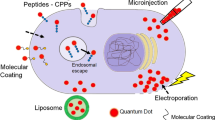Abstract
Quantum dots (QDs), as novel fluorescence probes, have shown a great potential for bio-molecular labeling and cellular imaging. To stain cellular targets, the sufficient intracellular delivery of QDs is required. In this work the tat, a typical membrane-permeable carrier peptide, was conjugated with thiol-capped CdTe QDs to form CdTe Tat-QDs, and the intracellular deliveries of CdTe QDs or CdTe Tat-QDs were compared in human hepatocellular carcinoma (QGY) cells and human breast cancer (MCF7) cells in vitro by means of confocal laser scanning microscopy. Added into the cell dishes, both QDs and Tat-QDs adhered to the outer leaflet of the plasma membrane of cells within a few minutes, but the binding amount of Tat-QDs was obviously higher than that of QDs. Then both QDs and Tat-QDs can penetrate into cells, and their cellular contents increased with incubation time but both saturated after 3 hours incubation. However the cellular levels of Tat-QDs were higher than those of QDs, with the ratio of 2.1 (±0.3) times in QGY cells and 1.5 (±0.2) times in MCF7 cells, demonstrating the enhancing effect of Tat conjugation on the intracellular delivery of QDs.




Similar content being viewed by others
References
Stephens DJ, Allan VJ (2003) Light microscopy techniques for live cell Imaging. Science 300:82–86
Weijer CJ (2003) Visualizing signals moving in cells. Science 300:96–100
Miyawaki A, Sawano A, Kogure T (2003) Lighting up cells: labeling proteins with fluorophores. Nat Cell Biol 5:S1–7
Wu H, Liu H, Liu J, Haley KN, Treadway JA, Larson JP, Ge N, Peale F, Bruchez MP (2003) Immunofluorescent labeling of cancer marker Her2 and other cellular targets with semiconductor quantum dots. Nat Biotechnol 21:41–46
Jaiswal JK, Mattoussi H, Mauro JM, Simon SM (2003) Long-term multiple color imaging of live cells using quantum dot bioconjugates. Nat Biotechnol 21:47–51
Chan WCW, Nie S (1998) Quantum dot bioconjugates for ultrasensitive nonisotopic detection. Science 281:2016–2018
Klarreich E (2001) Biologists join the dots. Nature 413:450–452
Liu T, Liu B, Zhang H, Wang Y (2005) The fluorescence bioassay platforms on quantum dots nanoparticles. J Fluorescence 15(5):729–733
Parak WJ, Pellegrino T, Plank C (2005) Labeling of cells with quantum dots. Nanotechnology 16:R9–R25
Larson DR, Zipfel WR, Welliams RM, Clark ST, Bruchez MP, Wise FW, Webb WW (2003) Water-soluble quantum dots for multiphoton fluorescence image in vivo. Science 300:1434–1436
Zahavy E, Freeman E, Lustig S, Keysary A, Yitzhaki S (2005) Double labeling and simultaneous detection of B- and T cells using fluorescent nano-crystal (q-dots) in paraffin-embedded tissues. J Fluorescence 15(5):661–665
Zhang P (2006) Investigation of novel quantum dots/proteins/ cellulose bioconjugateusing NSOM and fluorescence. J Fluorescence 16(3):349–353
Minet O, Dressler C, Beuthan J (2004) Heat stress induced redistribution of fluorescent quantum dots in breast tumor cells. J Fluorescence 14(3):241–247
Zhang H, Wang L, Xiong H, Hu L, Yang B, Li W (2003) Hydrothermal synthesis for high-quality CdTe nanocrystals. Adv Mater 15:1712–1712
Smith AM, Gao X, Nie S (2004) Quantum dot nanocrystals for in vitro molecular and cellular imaging. Photochem Photobiol 80:377–385
Hoshino A, Hanaki K, Suzuki K, Yamamoto K (2004) Applications of T-lymphoma labeled with fluorescent quantum dots to cell tracing markers in mouse body. Biochem Biophys Res Commun 314:46–53
Ma J, Chen JY, Guo J, Wang CC, Yang WL, Xu L, Wang PN (2006) Photostability of thiol-capped CdTe quantum dots in living cells: the effect of photo-oxidation. Nanotechnology 17:2083–2089
Medintz IL, Uyeda HT, Goldman ER, Mattoussi H (2005) Quantum dot bioconjugates for imaging, labelling and sensing. Nature Materials 4:435–446
Sukhanova A, Devy J, Venteo L, Kaplan H, Artemyev M, Oleinikov V, Klinov D, Pluot M, Cohen JHM, Nabiev I (2004) Biocompatible fluorescent nanocrystals for immunolabeling of membrane proteins and cells. Anal Biochem 324:60–67
Futaki S, Suzuki T, Ohashi W, Yagami T, Tanaka S, Ueda K, Sugiura Y (2001) Arginine-rich peptides—An abundant source of membrane-permeable peptides having potential as carriers for intracellular protein delivery. J Biol Chem 276:5836–5840
Vives E (2003) Cellular uptake of TAT peptide: an endocytosis mechanism following ionic interactions. J Mol Recognit 16:265–271
Guo J, Yang W, Wang C (2005) Systematic study of the photoluminescence dependence of thiol-capped CdTe nanocrystals on the reaction conditions. J Phys Chem B 109:17467–17473
Bullen C, Mulvaney P (2006) The effects of chemisorption on the luminescence of CdSe quantum dots. Langmuir 22:3007–3013
Futaki S (2005) Membrane-permeable arginine-rich peptides and the translocation mechanisms. Adv Drug Deliv Rev 57:547–558
Ziegler A, Nervi P, Durrenberger M, Seelig J (2005) The cationic cell-penetrating peptide Cpp(TAT) derived from HIV-1 protein TAT is rapidly transported into living fibroblasts: optical, biophysical, and metabolic evidence. Biochem 44:138–148
Takeuchi T, Kosuge M, Tadokoro A, Sugiura Y, Nishi M, Kawata M, Sakai N, Matile S, Futaki S (2006) Direct and rapid cytosolic delivery using cell-penetrating peptides mediated by pyrenebutyrate. ACS Chem Biol 1:299–303
Acknowledgements
This work is supported by Shanghai Municipal Science and Technology Commission (06ZR14005 and 04DZ05617) and the National Natural Science Foundation of China (60578045).
Author information
Authors and Affiliations
Corresponding author
Rights and permissions
About this article
Cite this article
Xue, F.L., Chen, J.Y., Guo, J. et al. Enhancement of Intracellular Delivery of CdTe Quantum Dots (QDs) to Living Cells by Tat Conjugation. J Fluoresc 17, 149–154 (2007). https://doi.org/10.1007/s10895-006-0152-2
Received:
Accepted:
Published:
Issue Date:
DOI: https://doi.org/10.1007/s10895-006-0152-2




